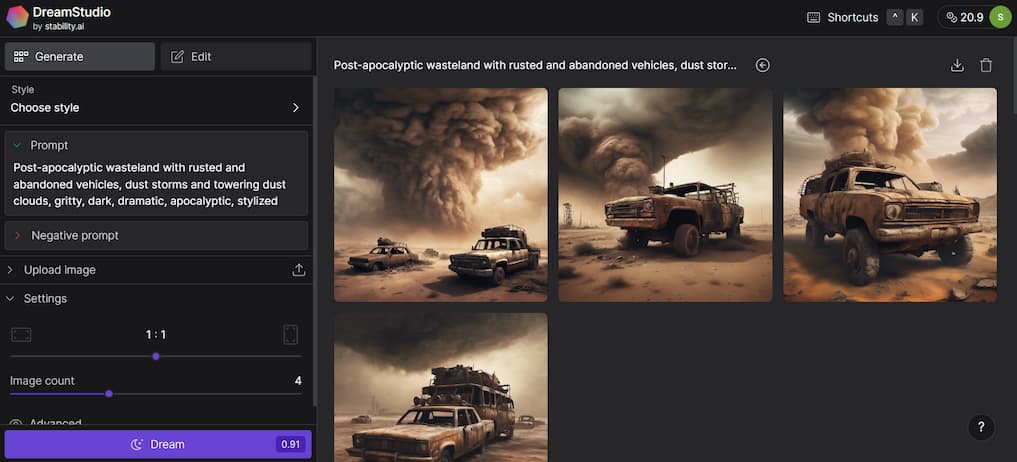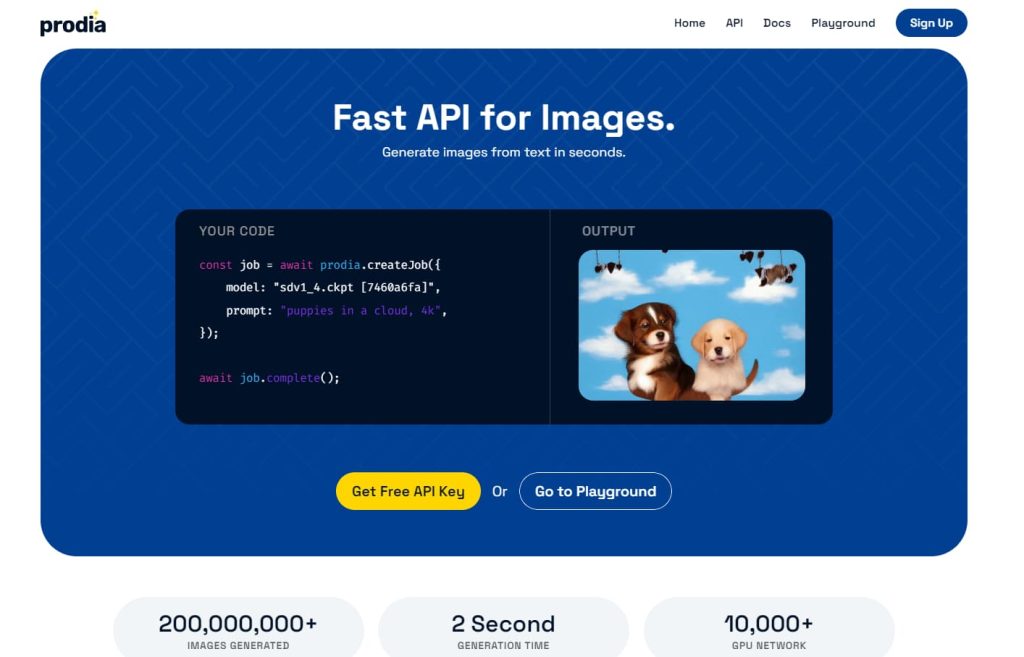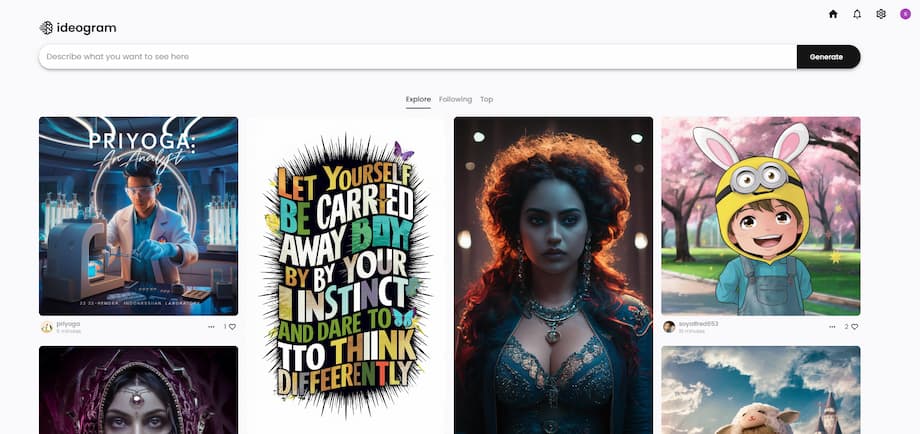AI image generation allows anyone to create mind-blowing art by using natural language. For example, using one of the AI image-generation tools featured in this article, you can easily create an image of a cat wearing a Superman cape in mere seconds.
As you can tell, this has opened the doors to a host of opportunities that simply didn’t exist before. Like being able to translate your ideas into compelling art using a few words or an advertising agency using AI to create highly personalized and targeted visual content tailored to specific audiences. The possibilities are endless.
In this article, we will take a deep dive into AI image generation and uncover what it is, how it works, the best AI image generation platforms and tools, and so much more. Let’s dive in!
What is AI Image Generation?
AI Image generation refers to the process of creating original, compelling, and photorealistic images from scratch or based on specific user input, such as text descriptions and prompts.
How AI Image Generation Works
AI image models aim to generate original and realistic images from text input. These models have been trained on billions of images and other huge amounts of data.
During the training, the machine learning algorithms break down and learn different aspects and styles of the image datasets. As a result, they can generate images based on the characteristics of the images in the training dataset.
To interpret text input, the AI image models use Natural Language Processing (NLP). The model breaks the text input into tokens that are converted into numerical labels for easy interpretation.
The result is AI text-to-image models generating high-quality images that closely match the text descriptions. In the next section, we’ll dive into the techniques and algorithms that make this possible.
AI Image Generation Techniques
Different AI Image models employ different algorithms and techniques for image generation.
Generative Adversarial Networks (GANs)
The Generative Adversarial Networks (GANs) technique was developed by Ian Goodfellow in a bar with his friends in 2014. GANs employ two competing neural networks – the generator and the discriminator.
As their names suggest, the generator generates a fake image that closely resembles the real image and the discriminator determines whether the generated image is real or fake.
This leads to a sort of reinforced learning that resembles that of a teacher and student. The discriminator is fed real images which it compares against the fake images generated by the generator. The generation is successful when the generator dupes the discriminator.
Diffusion
The diffusion model was invented by a Physicist who had a brilliant idea of using the diffusion concept in Physics on AI image generation.
Diffusion models progressively add noise (Gaussian noise) to an image in an attempt to reverse or remove the noise to reclaim the original image.
During this reversal process, the model learns how to recreate the image. This process is repeated on billions of images. Armed with this knowledge, the model can create new and original images based on this vigorous training and guided by the text input/prompt.
Best AI Image Generation Tools and Platforms
There exist many AI generation tools and platforms. AI image tools can be categorized into:
- Open-source: Open-source means the models are free to use. Also, the code and trainable weights are available for anyone to download. A good example is Stable Diffusion.
- Closed-source: Refers to proprietary software whose weights and code are not available to the public. Hence, users cannot download and use freely. For example, DALL·E.
Free AI Image generation tools & platforms
Below we dive into the best free AI image-generation platforms that you can get started with.
1. Stable Diffusion
Launched in 2022, Stable Diffusion has allowed users to generate unique, photorealistic images. You can download and fine-tune the model for specific applications or you can run the models on online platforms such as DreamStudio.
For example, enthusiasts have fine-tuned Stable Diffusion models on celebrities’ images to create the best Stable Diffusion celebrity models. One technique model creators have used to achieve this is Low-Rank Adaptation (LoRA).
The models come in different varieties such as:
- Stable Diffusion: It’s also referred to as the base model. There are currently different versions like Stable Diffusion 1.0, Stable Diffusion 1.5, and more. However, Stable Diffusion 1.5 is the most popular model for fine-tuning.
- Stable Diffusion XL (SDXL): A larger and more capable Stable Diffusion variant. It requires shorter prompts while generating super high-quality images. Despite being new, it has exploded in popularity leading to some of the best Stable Diffusion XL models.
- SDXL Turbo: A distilled version of Stable Diffusion XL. It’s built using the cutting-edge Adversarial Diffusion Distillation (ADD) method. This method leads to faster inference times, meaning images are generated ASAP.
- SDXL-Lightning: This is more of a method than a model. It enables users to generate images super fast compared to SD, SDXL, and SDXL Turbo. It also works with shorter prompts.
2. Microsoft Copilot Designer

Copilot Designer is Microsoft’s free AI image generator that’s powered by OpenAI’s DALL·E 3. It’s built into Copilot and capable of generating a wide variety of images such as artwork, greeting cards, creative presentations, and more.
Unlike DALL·E 3, Designer has a complete suite of image editing tools that you can use to enhance or personalize a generated image. The design tools allow you to add text, branding, filters, and other designs.
3. Craiyon

Craiyon is one of the best free AI image generators because it generates high-quality images in different styles. These styles consist of anime, cartoons, art, photography, drawing, and more.
The interface is straightforward to use which appeals to beginners. To get inspiration, there’s a gallery on the homepage of other user’s creations along with the prompts. Feel free to use these prompts to inspire your next creation.
4. Civitai

Civitai is a popular hub for generating images, sharing, and exploring AI image models. What’s unique about Civitai is its wide variety of fine-tuned models. There are thousands of models to choose from with more added every day.
This gives you creative control and variety over image styles. Enthusiasts can engage with the vibrant community to learn the latest techniques in image generation and model fine-tuning.
5. Leonardo AI

Leonardo AI is one of the top image-generation platforms. It has a free-forever plan and also premium plans. The free plan awards registered users 150 tokens per day which can generate around 80 images depending on the model selected.
The free version gives users access to many features such as model selection, advanced controls, upscalers, and prompt generation. Leonardo AI especially stands out thanks to its custom models such as Leonardo Diffusion XL and Leonardo Lightning XL.
6. DreamStudio for Stable Diffusion

Dream Studio is an online platform by Stability AI that allows users to generate images using the latest Stable Diffusion models. You can generate images using pre-defined styles, negative prompts, and other settings.
The free and paid online tool is a fantastic avenue for practicing prompting Stable Diffusion models. Furthermore, it has an API you can connect to and generate images from a third-party app.
7. Prodia

Prodia is a simple and free online AI image-generation tool. It has 50+ unique models that generate images in different styles.
Some of the models available on Prodia include Dreamshaper, Juggernaut, Absolute Reality, Epic Realism, Realistic Vision, and so much more.
Image generation is fast and of high quality. You can also access advanced settings such as CFG scale, steps, and seed to optimize the resulting image.
Paid AI Image generation tools & platforms
Now let’s discuss the best paid AI image generation tools and platforms.
1. Midjourney

Midjourney is currently the most popular paid AI image generation platform. Its huge success is attributed to its tight-knit community and high-quality images achieved using shorter prompts and fewer settings.
The above reasons make Midjourney the best AI image generator for beginners. There’s barely any learning curve as compared to Stable Diffusion. A Midjourney subscription starts at $8/m all the way to $120/m for super users.
2. DALL·E 3

DALL·E 3 is OpenAI’s image generation model that’s incorporated into ChatGPT-4. For starters, this makes it easy to use especially if you’re accustomed to ChatGPT. When I can’t get the image right, I ask ChatGPT to help me craft the right prompt for DALL·E 3 which it does accurately.
A $20 ChatGPT-4 subscription includes DALL·E 3. The only downside to DALL·E 3 is the images have a specific look and feel that’s easily detectable. That said, it’s perfect for branding, creating stock photos, iconography, and other trivial use cases.
3. Ideogram

Ideogram is a less-known AI image generation platform that I consider versatile and powerful. I use it to generate high-resolution images of fantasy art, cyberpunk, anime, cartoons, paintings, people, and much more.
You can get started with a free but limited trial to test the platform. My favorite use case is generating logos. It gets the text right compared to other AI image generators that fail at incorporating text accurately. You can get started for as low as $7/month for 1,600 images/month.
4. Nightcafe

NigtCafe is one of my favorite AI image-generation tools for several reasons. For starters, you can generate your images using one of the many available models to achieve different styles.
Second, you can fine-tune your own AI model according to a custom style. Better yet, you can upload images of your face to fine-tune a model and create images of yourself in various styles and scenarios. Lastly, Nightcafe has a vibrant community of talented AI artists and enthusiasts that will motivate you.
5. Mage.space

Mage.space offers a free-forever trial to users but you’re limited to three models for generating images, they consist of Stable Diffusion XL, Stable Diffusion 1.5, and Stable Diffusion 2.1.
To unlock other models you’ll need a subscription. For example, the basic plan($8/m) gives you access to 160+ models, exclusive models, and unlimited creations. With a $30/m subscription, you can import your own models from Civitai or other sources and run them on the platform among other features.
AI Images: Applications & Use Cases

The applications of AI image generation are extensive. It can be used in almost any industry available today
1. Art
Generative AI for images has democratized art creation. Anyone can now turn their ideas into images through text. The simplicity, versatility, and cost-effectiveness has led to an explosion of AI artists.
Text-to-image models are trained on billions of art and photography making them powerful art machines capable of recreating almost any type of art style. For this reason, they stimulate creativity, experimentation, and exploration of new artistic styles and visual aesthetics, pushing the boundaries of digital art creation.
2. Education and Learning
Text-to-image models facilitate visual learning and comprehension by converting textual descriptions into images, diagrams, or illustrations.
Educators and trainers can use text-to-image applications to create educational materials, textbooks, and interactive learning resources, making complex concepts more accessible and understandable for students.
3. Marketing & advertising
AI and AI Images are a game-changer in marketing and advertising. So much so that Sam Altman – the CEO of OpenAI – recently claimed that AI will do 85% of marketing functions.
AI-generated images can be used for product visualization, personalized images for email campaigns, social media posts, content creation and distribution, and so much more. In advertising, AI images are instrumental in creating targeted advertisements for specific audiences which can improve click-through rates, and drive conversions.
4. Architecture
Text-to-image models offer significant benefits in architecture by bridging the gap between textual descriptions or specifications and visual representations of architectural designs.
Using text-to-image models in architecture offers several advantages such as conceptualization and visualization, iterative design process, communication and collaboration, design exploration and creativity, efficiency and time savings, and more.
5. Fashion
Generative AI has great potential to empower fashion designers and elevate their output to new heights. For example, text-to-image models can help designers develop design concepts, facilitate rapid prototyping and iterations, and suggest and visualize ideas.
Ethical and Social Implications

Despite the enormous benefits of AI image generators, there are also downsides to this novel technology. These include:
Misuse
AI-generated images can be misused and used for malicious purposes such as creating fake news, spreading misinformation, generating false evidence, and more. Such misuse can lead to serious consequences.
Privacy concerns
AI image generation sounds the alarm on individual privacy in cases where a person’s likeness is used without their consent. A good example is Taylor Swift’s Deepfakes scandal.
Bias and stereotypes
The datasets used to train AI models often reflect the biases present in society, leading to the perpetuation of stereotypes and the reinforcement of existing inequalities. If not carefully curated, AI-generated images may inadvertently reinforce these biases, exacerbating social divisions and discrimination. Like in the case of Google’s Gemini image generation bias.
Impact on creative industries
Traditional artists and photographers stand to be affected by the emergence and development of AI text-to-image models. AI-generated content blurs the lines between original creation and algorithmic replication, raising questions about attribution, ownership, and the intrinsic value of human expression.
Conclusion: How to Generate AI Images
AI image generators have forever changed how humans conceive and create art. For starters, you no longer need to be an artist to create art; AI image generators allow anyone to turn their ideas into art using natural language in a fraction of the time.
This has led to a sharp rise in the adoption of AI image-generation tools not just by individuals but also by industries and professions. AI image generators have been adopted in professions such as Graphic Design, Fashion, Marketing and Advertising, and many more.
However, we also have to consider the serious implications of AI image generators. These implications consist of misuse, privacy breaches using deepfakes, bias, and more. With this in mind, we should use AI responsibly and enact laws that prevent misuse.
FAQs: AI Image Generation
Below find frequently asked questions on AI image generation.
1. How do I generate AI images from text?
You can generate AI images from text using various AI image generation platforms such as Stable Diffusion, Microsoft Copilot Designer, Craiyon, Civitai, Leonardo AI, and more. These platforms allow you to input text prompts and generate corresponding images.
2. What are some best practices for generating AI images?
Some best practices for generating AI images include providing clear and specific text prompts, experimenting with different prompts and parameters to achieve desired results, and critically evaluating the generated images for quality and relevance.
3. Are there any limitations to AI image generation?
AI image generation has made significant advancements, but there are still limitations. These include challenges in generating highly detailed or contextually accurate images, potential biases in generated content, and the need for large datasets for training high-quality models.
4. What are some risks associated with AI-generated images?
Risks associated with AI-generated images include the potential for misuse, such as creating deepfakes for deception or manipulation, privacy concerns related to unauthorized use of individuals’ likenesses, and the perpetuation of biases present in training data. It’s important to address these risks through responsible use and regulation.
- Best Prompt Library for Every Use Case [Free & Paid] - August 26, 2025
- How to Build a AI Career Chatbot That Acts Like You [Easy] - July 18, 2025
- 10 Best Prompt Engineering Frameworks For Every Profession - June 17, 2025

